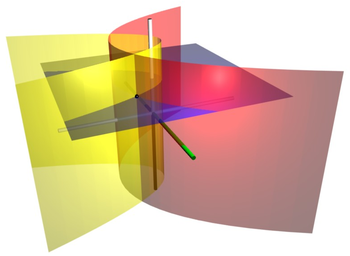Coordinate surfaces of parabolic cylindrical coordinates. Parabolic cylinder functions occur when separation of variables is used on Laplace's equation in these coordinatesPlot of the parabolic cylinder function D v(z) with v=5 in the complex plane from -2-2i to 2+2i with colors created with Mathematica 13.1 function ComplexPlot3D In mathematics , the parabolic cylinder functions are special functions defined as solutions to the differential equation
d
2
f
d
z
2
+
(
a
~
z
2
+
b
~
z
+
c
~
)
f
=
0.
{\displaystyle {\frac {d^{2}f}{dz^{2}}}+\left({\tilde {a}}z^{2}+{\tilde {b}}z+{\tilde {c}}\right)f=0.}
(1 )
This equation is found when the technique of separation of variables is used on Laplace's equation when expressed in parabolic cylindrical coordinates .
The above equation may be brought into two distinct forms (A) and (B) by completing the square and rescaling z , called H. F. Weber 's equations:[ 1]
d
2
f
d
z
2
−
(
1
4
z
2
+
a
)
f
=
0
{\displaystyle {\frac {d^{2}f}{dz^{2}}}-\left({\tfrac {1}{4}}z^{2}+a\right)f=0}
(A )
and
d
2
f
d
z
2
+
(
1
4
z
2
−
a
)
f
=
0.
{\displaystyle {\frac {d^{2}f}{dz^{2}}}+\left({\tfrac {1}{4}}z^{2}-a\right)f=0.}
(B )
If
f
(
a
,
z
)
{\displaystyle f(a,z)}
f
(
a
,
−
z
)
,
f
(
−
a
,
i
z
)
and
f
(
−
a
,
−
i
z
)
.
{\displaystyle f(a,-z),f(-a,iz){\text{ and }}f(-a,-iz).}
If
f
(
a
,
z
)
{\displaystyle f(a,z)\,}
A
f
(
−
i
a
,
z
e
(
1
/
4
)
π
i
)
{\displaystyle f(-ia,ze^{(1/4)\pi i})}
B
f
(
−
i
a
,
−
z
e
(
1
/
4
)
π
i
)
,
f
(
i
a
,
−
z
e
−
(
1
/
4
)
π
i
)
and
f
(
i
a
,
z
e
−
(
1
/
4
)
π
i
)
{\displaystyle f(-ia,-ze^{(1/4)\pi i}),f(ia,-ze^{-(1/4)\pi i}){\text{ and }}f(ia,ze^{-(1/4)\pi i})}
B
^ Cite error: The named reference Weber was invoked but never defined (see the help page ). 









